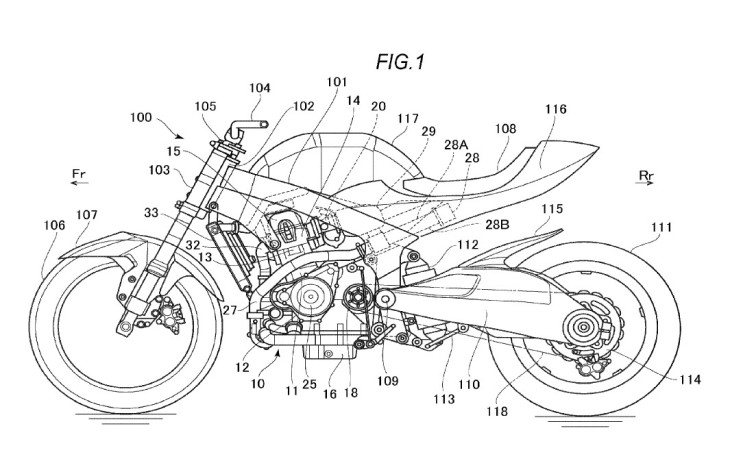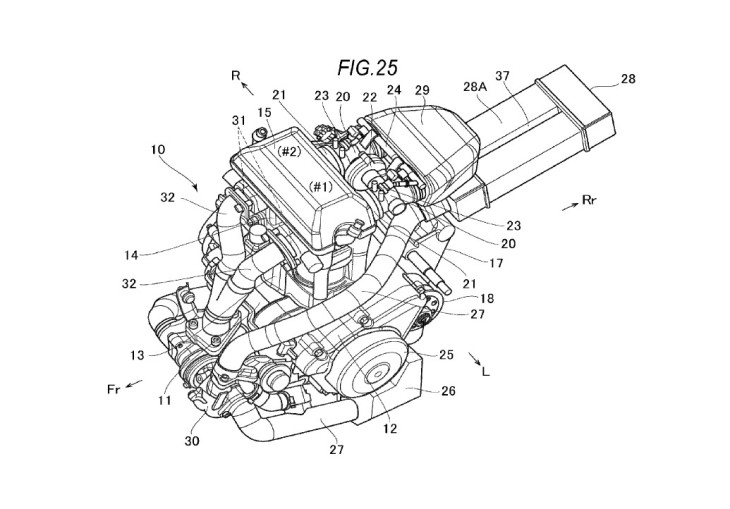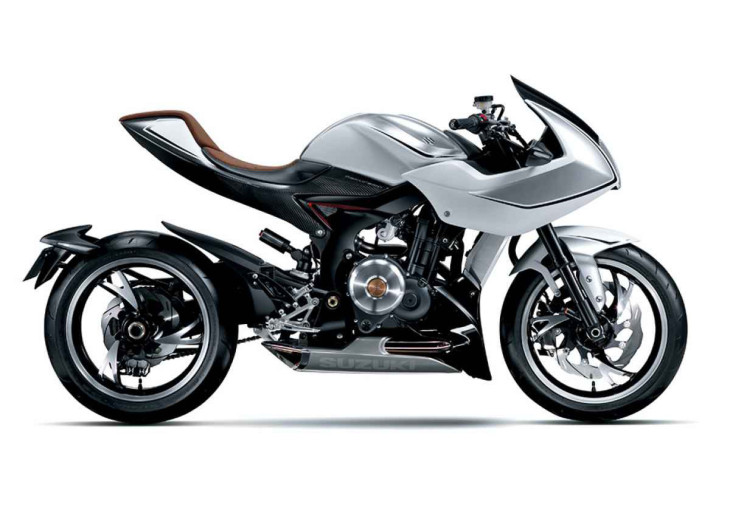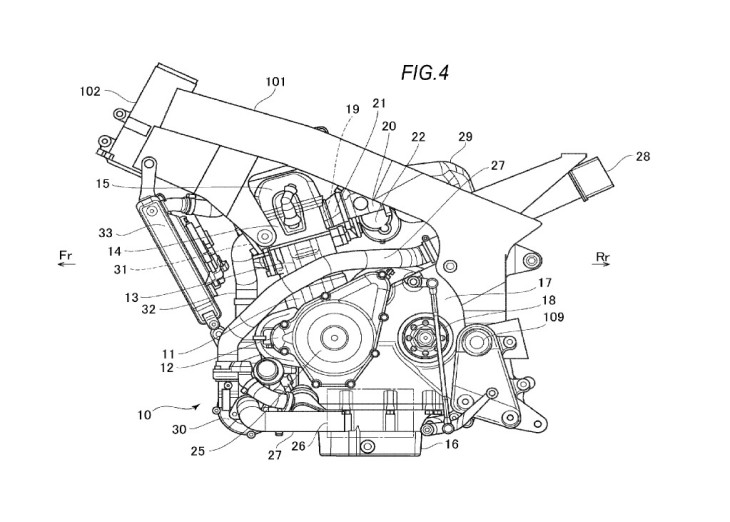A recently published Suzuki patent application, which you can read in full by following this link to the PDF, points to the production of a forced induction motorcycle similar to the Recursion concept we have written about previously. Just as several automobile manufacturers now claim smaller displacement engines with forced induction offer improved fuel economy without sacrificing power, Suzuki is making the following statement regarding its proposed patented design:
In order to improve a fuel economy of an engine and to improve an engine power in a vehicle such as a motorcycle, there is a case where a reduction of engine displacement and a supercharger are combined, namely, a reduction of engine displacement and an improvement of intake efficiency real ized by a supercharger are simultaneously conducted.
Interestingly, this claim has not always proved accurate in the automobile world, where Consumer Reports reached the following conclusion after testing numerous models relevant to the claim:
Small turbocharged engines are marketed as delivering the power of a large engine, with the fuel economy of a smaller one. That’s a tempting proposition, but our testing shows these small-displacement turbos are not delivering on the promises.
In the article, Consumer Reports found several larger displacement, normally aspirated engines offered both better economy and quicker acceleration than the smaller displacement, forced induction engines in the same vehicle. CR’s testing report is now a couple of years old.
Suzuki has indicated the Recursion concept, a 588 cc parallel twin, could provide massive increases in both peak horsepower and mid-range torque compared to a normally aspirated engine, without a significant fuel economy penalty. Unlike Kawasaki’s new H2, which lacks an intercooler, Suzuki’s design incorporates a mechanism to cool the compressed air feeding the throttle bodies. Although the patent application (published just a few weeks ago) doesn’t guaranty production, it makes it more likely.










I recall seeing that in Consumer Reports, and didn’t have a sense of whether I agreed. It is too bad that they did not cite the examples that led them to that conclusion. One example that might be relevant to the question is the new 2015 Mustang. The V6 engine and the turbo-four ecoboost are similar in peak power, from what I recall off the top of my head, but the turbo-four has a substantial advantage at low rpm. I don’t know which is lighter or which has better EPA numbers.
I reckon a 588cc parallel twin weighs less than a 1000cc inline four.
Power levels on motorcycles have been more than more than adequate (and have climbed) for a couple of decades. Handling and braking have also progressed. What has not really improved is fuel mileage. What used to be a slam dunk when comparing with cars is no longer so. Today I can think plenty of 4-wheelers that use less fuel than many, perhaps most bikes routinely sold in the US.
This is the area that could improvement.
I think that was about P (Pressure)/V (Volume) graphs that reflect the power of the engines.
Cooler air/fuel mixture occupies less volume.
I think the main reason for cooling the hot compressed intake air, is to reduce the chance of pre-ignition. True, you can pack more air/fuel in the cylinder if it is cooler, but as the cylinder rises toward TDC, it is compressing the mixture more, and getting even hotter. Too hot, and it ignites before the spark timing.
Yes, fuel/mixture flame is a VERY interesting story.
Every thing is better when blown……
Dropped off my car with my wrench for service last Friday. He mentions he just bought a 2015 full size Dodge RAM half ton pickup that got 23mpg cruising “70-80mph.” Me thinks this sounds suspect till he shows me the EPA rating for his car, rated to tow “9200 lbs:” 20 city/28 freeway.
Little 3.0L V6 turbo diesel.
Wonder if the H2 can match 28mpg on a track day or with aggressive canyon charging.
He won’t be seeing b those numbers if he’s towing to limit. Motorcycles have a tough time with meeting mpg expectations simply because of the way most of us ride them.
re: “He mentions he just bought a 2015 full size Dodge RAM half ton pickup that got 23mpg cruising “70-80mph.” Me thinks this sounds suspect till he shows me the EPA rating for his car, rated to tow “9200 lbs:” 20 city/28 freeway.”
wait till you see the new “Americanized” Nissan Titan with it’s domestic built 5.0 Liter Cummins V8. it’s got a turbo so crazy, I have YET to figure out…? not that IS crazy. lol
now…
Cooler air is always an advantage. Turbos need an intercooler because they’re operated from a mechanism driven by hot exhaust gases. Super chargers are driven by mechanical means usually far removed from hot exhaust gases, thus an intercooler is generally not quite as necessary but again, cooler air is always advantageous. This is why I called out the comment where Suzuki made it appear that they have an advantage with their intercooler. I believe Kawasaki would have thrown in an intercooler if it would have improved the overall H2 & H2R performance package. I mean, we’re not talking about a small eco motor using a super charger for fuel efficiency. This is a $25,000-$50,000 pure performance machine with no compromises! That being said, I’m sure Kawasaki would have designed an intercooler if it would have added a little bit more horsepower… Why not go all the way if you’re going all the way?! 😉
What? It’s the compression of the intake charge that heats it up, not heat transfer from the exhaust in the case of a turbo vs. a supercharger.
re: “What? It’s the compression of the intake charge that heats it up, not heat transfer from the exhaust in the case of a turbo”
nope, his statement is 100% correct. though not at the same temperature, turbine heat migrates forward along the shaft to the compressor. the entire rotating assembly is hot, as well as the housing.
more specifically, heat in the compressed air has 2 sources in turbo charged applications. particularly when gasoline is used as the fuel type as EGT’s are higher than with diesel, which themselves can get high enough to damage components.
Certainly heat conducts through the shaft, continually, but heat is also being removed from the compressor by the constant flow of air. I don’t have any hard facts on the question, but the seat of my pants tells me that the compressor blades remain at a temperature very close to the ambient air temp, and not much higher. And there is more than one way to look at the benefit. The intercooler appreciably reduces the pressure on the high-pressure side of the compressor, which intuitively suggests that the turbine and compressor spin faster, which means that air moves through the compressor at greater air current, i.e., molecules per unit time. (Air volume per unit time isn’t a good way to express air current unless temperature and pressure are specified.)
I’ve thought for a long time that a supercharged single would be a good idea. Light enough for a sport bike or even a sport touring bike.
Back in the day when Honda was experimenting with “alternative” designs for 500 GP engines (such as oval cylinders) they built a 250cc (reduced displacement due to rules governing forced induction) tubocharged single four stroke. If I recall correctly, the engine made competitive power, but was too complex and heavy to compete with the two stroke fours.
The new EcoBoost Ford truck engine is small, twin turbo charged for minimal turbo lag, give great milage and accelerates like and better then the bigger V8’s.
I know, I have one and am amazed at the advancement in technology in the last 5 years.
It will only get better.
Also, I believe in an electric boost system. They are being confirmed in General Aviation
at present..
cheers
Very interesting that this article states “Unlike Kawasaki’s new H2, which lacks an intercooler, Suzuki’s design incorporates a mechanism to cool the compressed air feeding the throttle bodies.” This is because the Suzuki patent shows a turbocharger which needs an intercooler. Funny how it gets twisted wear something not needing in intercooler is cited for not having one. Just sayinc…
All forms of forced induction benefit from intercoolers. Packaging is the bigger issue with bikes.
Turbo chargers don’t need intercoolers. Kawasaki’s GPZ750E turbo was an air cooled engine and didnt run an intercooler and that was the fastest production bike in the world when it was released. Yamaha, Suzuki, and Honda also produced T/C bikes without the aid of an intercooler. As Dirck says, they forced bikes would benefit from it but its just not always neccesary.
At the compression ratios that are common today it is becoming difficult to do a turbo with meaningful benefit without an intercooler. The street-going H2 “only” has 200hp, not impressive considering what other makes are achieving normally aspirated. This 650 twin will need to pull 110-120hp or an incredible torque curve to justify its complexity against existing bikes.
re: “Turbo chargers don’t need intercoolers.”
correct, they are “niceties” not necessities.
“Need” is almost always a relative thing. Many things that are advantageous are not essential. Nowadays in car applications, intercoolers are ubiquitous with both turbocharging and supercharging. If it isn’t obvious why, it can be useful to understand it by way of the fact that lowering the temperature of the air on the high-pressure side of the compressor also lowers the pressure and allows the compressor to be more efficient. This isn’t the only advantage. Someone else here mentioned reduced tendency for detonation, and would certainly be another very meaningful advantage, since it allows more complete combustion through less retarding of ignition timing. And in modern turbos where the ECU overrides the basic (mechanical) limit on boost to permit higher level of boost (controlling a valve that conducts intake vacuum to the sealed chamber on one side of the little canister thingie where you see the rod that operates the waste gate or turbine bypass), detonation or knock will in general cause the ECU to reduce boost, rather than retard ignition. Thus, by reducing the tendancy for detonation, intercooling in a turbocharged engine permits a higher level of boost. In a turbocharged engine this is managed continually by the ECU, but even in a supercharged engine that does not have a turbine with a bypass that the ECU controls, the intake manifold pressure that can be tolerated, without detonation, is greater by virtue of the reduction in intake air temperature. Thus, the use of intercooling permits using a more powerful compressor, as compared to what would be permissible without the intercooler.
Good explanation. Thanks.
I’d like Suzuki to use their big 650 single and put it into a retro thumper ! Goldstar / Manx / Velocette/mmmmmSRX. I know old and dreaming of days gone bye…..
Agreed! I do admire Suzuki for being faithful to old design scoots. I’ve never ridden a Savage 650 but I would like to. just because it’s different and it has been around forever. Just like their DR650, which as far as I know, is the same mill, helping to keep production costs down. I like the belt drive on the Savage too.
Totally different motors in those two. Would love a TU650X though
Very good come back! That would make sense and a sweet ride !
Yes.
I would like a TU 400 with no supercharger. Or TU 500.
Counterbalanced of course.
The SR400 is just a tad high in price. $1-2,000 matters on a toy bike which all bikes are in the USA.
I’d thought for a long time that forced induction made sense for cycle makers but today’s normally aspirated motors are so compact, light and powerful it hardly makes any sense at all. Why build a 600 with the power of a 1000 if it isn’t any lighter or more compact?
The reason will be for the same reason auto makers do it, it’s a HP race and cycle makers don’t have to claim better MPG like the car makers since MPG is almost irrelevant for bike buyers. They will pretend it has practical advantages but it will mostly be having to have forced induction bikes since their competitors do. That and the appeal of 200hp/liter, just because.
That said I’d lust after a modern Honda CX650 Turbo in sport touring guise.
I conjure the power of the “H2R” and “Turbo lag” to this thread!!
Joke aside, I wonder why the engine doesn’t drive a bigger alternator and a electric turbo…, that way the same computer that checks and manage power delivery controls turbo boost, somewhere I read an electric approach to valves did also improve performance (just like we did with the fuel injection…. injectinos ~~).
It uses a mechanically-driven supercharger, not a turbocharger. No lag…
All of the diagrams show a turbocharger. Superchargers are not plumbed into the exhaust system.
My mistake, I was relying on a report from a different site. The diagrams do indeed show a turbocharger.
Have they eliminated turbo lag? That is something you don’t want when riding a motorcycle. If having a turbo means lower fuel consumption and reduced emissions for the same power output as larger engines, it is a good thing. But if it just means you get a more complex and more expensive bike, forget it. And don’t think that it means lighter bikes having the same power as larger bikes. I doesn’t work that way. If a bike as 200hp the whole bike has to be built to cope with 200hp. If you boost a 600cc engine to produce the same power as a 1000cc bike the whole bike has to be built like it is a 1000cc, except the cylinders, heads and pistons will be smaller. Any weight savings from that will be lost in the extra weight of the turbo, plumbing and control system.
Hey, we’ve seen this show before. Really complicated, kind of expensive, not quite ready for prime time…. Didn’t the RE-5 wankel make all those promises too?
sad, the RX8 has been my crush car for a long time… but I don’t have the money to have an “on continuous repair” car
Wankel engines are pretty reliable. 1/3rd the moving parts. No valve train, rotors that turn @ 1/3rd the crank output speed. Can’t bust em’. What problems did the RX8 have? My old RX-7 (’79 with a tricked 13b engine) was great until I broke the transmission.
https://www.youtube.com/watch?v=zxsY4lEGRBI
I laughed so hard at that as I do all those Hitler gets upset videos. Some people are very clever. Cracks me up.